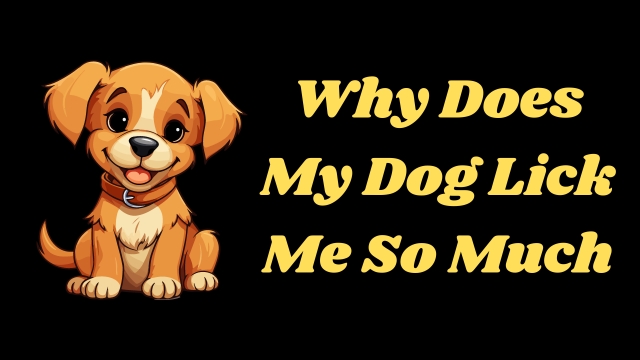Why Does My Dog Lick Me So Much
Read Also - Boy Hair Style Images || Boy Hair Style Images Download || Hairstyles Boys Wallpapers
The joy of being greeted by a slobbery canine kiss is a familiar experience for many dog owners. While it might leave you wondering, "Why does my dog lick me so much?" canine licking is a multi-faceted behavior that serves various purposes. In this comprehensive exploration, we'll delve into the reasons behind this endearing behavior, from expressions of affection to communication and more.
Chapter 1: The Language of Canine Communication
Before we explore the specific reasons why dogs lick, let's establish a foundation by understanding the language of canine communication. Dogs use a variety of behaviors to convey their feelings, including body language, barking, and licking. This chapter will outline the basics of how dogs communicate with humans and other dogs, emphasizing the role of licking in their social repertoire.
Chapter 2: Affectionate Licking - A Display of Love
One of the most common reasons dogs lick their owners is to express affection. Dogs are pack animals with a strong sense of loyalty, and licking is a way for them to show love and bond with their human family members. This chapter will explore the emotional aspect of licking and how it strengthens the human-canine bond.
Chapter 3: Puppies, Motherhood, and Comfort Licking
In the early stages of a dog's life, licking is a crucial part of maternal care. Mother dogs lick their puppies for grooming, bonding, and to stimulate urination and defecation. This behavior often carries into adulthood, where dogs may continue to lick their owners as a way to seek comfort and reinforce their bond. This chapter will delve into the connection between puppyhood, motherhood, and the comfort aspect of licking.
Chapter 4: Social Hierarchy and Submission Licking
In the wild, wolves and other canids use submissive behaviors to maintain social harmony within the pack. Licking is one such submissive behavior that signifies acknowledgment of a higher-ranking member. In a domestic setting, dogs may lick their owners as a way to show submission and respect. This chapter will explore the concept of social hierarchy and how it manifests in the act of licking.
Chapter 5: The Tasty Trail - Exploration and Taste Sensation
Dogs explore the world with their noses and mouths, and licking is a part of their sensory exploration. Your skin might have interesting scents, tastes, or residues that attract your dog's curiosity. This chapter will discuss how dogs use licking as a way to gather information about their environment and the people they love.
Chapter 6: Cooling Down and Thermoregulation
Dogs don't sweat the way humans do, and they rely on alternative methods to cool down. Licking their fur and the skin of their owners helps distribute saliva, which, when evaporating, can have a cooling effect. This chapter will explore the role of licking in a dog's thermoregulation process and how it contributes to their overall comfort.
Chapter 7: Stress and Anxiety - Seeking Soothing Solace
Similar to humans biting their nails or twirling their hair when anxious, dogs may resort to licking as a self-soothing mechanism. If your dog is stressed, anxious, or facing a new or overwhelming situation, excessive licking might be their way of seeking comfort. This chapter will explore the connection between stress, anxiety, and licking behavior.
Chapter 8: Medical Considerations - Itching and Pain
Sometimes, excessive licking can be a sign of underlying medical issues. Skin irritations, allergies, or pain can lead dogs to lick a specific area compulsively. This chapter will highlight the importance of paying attention to changes in your dog's licking behavior and seeking veterinary advice if there are concerns about their health.
Chapter 9: Attention-Seeking Behavior
Dogs are social animals that thrive on interaction with their human companions. Licking can be a way for them to seek attention, especially if they've learned that licking leads to a positive response from their owners. This chapter will explore the attention-seeking aspect of licking and provide insights into managing and redirecting this behavior when needed.
Chapter 10: The Importance of Setting Boundaries
While doggy kisses are often cherished, it's essential to establish boundaries to ensure a harmonious relationship. This chapter will discuss the importance of setting limits on licking behavior, especially if it becomes excessive or unwanted. Providing clear signals and positive reinforcement can help shape appropriate licking habits.
Chapter 11: When to Seek Professional Advice
While licking is generally a normal behavior, persistent changes or excessive licking can be a sign of an underlying issue. This chapter will guide dog owners on when to consult with a veterinarian or a professional dog behaviorist, what to expect during an evaluation, and potential interventions for addressing specific concerns related to licking.
Conclusion: Embracing the Canine Kisses
In conclusion, understanding why your dog licks you involves recognizing the multifaceted nature of this behavior. From expressions of affection to communication and sensory exploration, licking is a rich and complex aspect of canine-human interaction. By appreciating the various reasons behind your dog's kisses and establishing healthy boundaries, you can nurture a loving and mutually respectful relationship with your furry friend. So, the next time your dog showers you with slobbery kisses, embrace the moment and revel in the unique bond you share.


